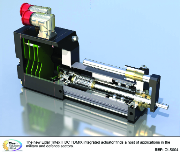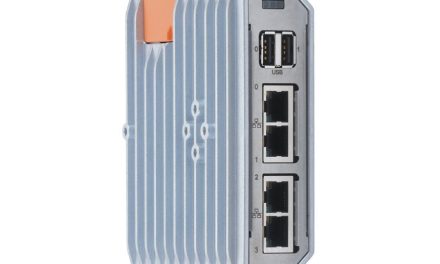 Piers Olsen of Olsen Engineering looks into why defence and aerospace companies are moving away from hydraulic actuation towards electromechanical, and explains why this is a sensible choice for design engineers
Piers Olsen of Olsen Engineering looks into why defence and aerospace companies are moving away from hydraulic actuation towards electromechanical, and explains why this is a sensible choice for design engineers
At a recent conference, Rolls Royce revealed a roadmap for bothits marine and aircraft divisions for the next five years, which demonstrated a move away from hydraulic actuation towards electromechanical actuation. The MoD has also shown an inclination to make this move, and manufacturing companies like BAE now see the future in all-electric actuation because of reduced fire risk oil, leaks and reduced maintenance.
In the US, meanwhile, the Office of Naval Research has stated: “The move to integrated all-electric designs will significantly improve efficiency, effectiveness and survivability while simultaneously increasing design flexibility, reducing costs and enhancing quality of service’’.
Electric actuation benefits
The key benefits of servo electric actuation are reduced cost, elimination of the need for sophisticated hydraulic controls and simpler logistical setup and maintenance. Furthermore, there is no hydraulic fluid pumping system, which is susceptible to leaks of flammable and carcinogenic oil, and has been the cause of numerous aircraft incidents over the last 10-20 years.
Electric actuation makes military vehicles, crafts and vessels less vulnerable in combat. In aircraft, for example, it does away with hydraulic lines in the fuselage and wing box, is light in weight and facilitates smaller aircraft and unmanned aircraft design.
All-electric design
Increased efficiency is another major benefit as there is only one energy conversion process. The trend towards all-electric design is fuelling this development. On ships, for example, the prime mover, such as a fuel-burning turbine, will convert the energy directly to electricity for powering motors and actuators around the vessel, instead of conventional mechanical power transmission, including the motors driving the propellers.
Soon, all the hatches, valves and firing mechanisms will be electrically powered as well. According to US publication Military and Aerospace Electronics, electric power is already the solution for industrial applications that need tremendous torque. Designers of military vehicles, in fact, see electric power as the next great frontier.
The IEEE (Institute of Electrical and Electronics Engineers) has also stated there is a general move in the aerospace industry to increase the amount of electrically powered equipment on future aircraft.
High power electric actuation systems are being proposed on many new aircraft, with most new aircraft designs now using electrically actuated ball screws driven by electric motors for the spoilers, some flaps and flight controls instead of hydraulic motors.
Installation time and cost is one of the biggest issues of hydraulics, because piping a kilometre or two of hydraulic hose requires minimum radius bending and screwing in for attachment to bulkheads in order to withstand vibration. In contrast, an electric cable simply attaches by means of cable ties and is easily fed through from one space to another.
 The latest US surface fleet features a number of aircraft carriers sporting several hundred Exlar electric actuators for hatches, loading mechanisms, jet blast doors, deflectors, lifts, firing pins and winches. In the UK, Exlar actuators have found applications in a Queen Elizabeth Class aircraft carrier for control valves for fuel metering. The mechanical adaptation, including the stainless steel pillars and tie-rods, were manufactured in the UK. The customer was BAE Systems and the valve control was MOD specified.
The latest US surface fleet features a number of aircraft carriers sporting several hundred Exlar electric actuators for hatches, loading mechanisms, jet blast doors, deflectors, lifts, firing pins and winches. In the UK, Exlar actuators have found applications in a Queen Elizabeth Class aircraft carrier for control valves for fuel metering. The mechanical adaptation, including the stainless steel pillars and tie-rods, were manufactured in the UK. The customer was BAE Systems and the valve control was MOD specified.
Exlar electromechanical actuation has also found applications in defence and aerospace for munitions handling, weapons positioning, ammunition magazine control, valve control, hatch opening and closing, tank turret control and gun and camera mounting. Aerospace and flight applications include flight simulators, fuel flow
control, inlet guide vanes (IGV) on Gas Turbines, and Variable Geometry Diffusors (VGD) for controlling the back pressure on the exhausts, bleed valves, flight surface control, cargo conveyors and helicopter rotor positioning. There have also been Exlar actuators supplied for Nuclear Submarine applications where they must operate in sea water if breached for a minimum of 30 days at up to 10,000 feet below sea level.
Missile steering and trajectory
Munitions and weapons applications include artillery handling, weapons positioning and loading, missile steering and trajectory control, and gun elevation. In the case of military shipboard applications, this includes jet blast deflector control, door and hatch opening and closing, towed array handling systems, cargo conveyors, load ramp positioning, hatch securing pins and elevator doors, while ground systems applications include guidance systems positioning and satellite positioning.
The US Gerald Ford carrier, for example, has an automated launch and recovery system featuring a jet blast deflector system at four launch stations. The actuators were customised and tested against explosion impacts, with six individual panels per launch station and one actuator per panel. An integrated catapult control station – ICCS – system consists of two lift actuators which raise and lower the ICCS cab, and four lock actuators to secure the cab in the raised or lowered position.
Benefits
 Using Exlar electric actuators in defence and aerospace offers reduced cost, removes the need for complex hydraulic controls and reduces cost of use over the life of the system. Simpler logistical setup and maintenance results from the elimination of the hydraulic power supply and distribution system, together with the maintenance associated with hydraulic fluid, contaminated oil supply, fluid leaks and fire. This, in turn, also reduces combat vulnerability.
Using Exlar electric actuators in defence and aerospace offers reduced cost, removes the need for complex hydraulic controls and reduces cost of use over the life of the system. Simpler logistical setup and maintenance results from the elimination of the hydraulic power supply and distribution system, together with the maintenance associated with hydraulic fluid, contaminated oil supply, fluid leaks and fire. This, in turn, also reduces combat vulnerability.
The omnipresent demand for light weight in defence and aerospace design provides additional impetus for electric actuation, whose integrated design provides maximum force density and eliminates the need for fluid power subsystems. Increased efficiency results from the utilisation of the existing energy system, without the need for additional fluid power supplies or associated systems.
Exlar actuators are distributed in the UK by Olsen Engineering,
Olsen Engineering T: 01686 689812

